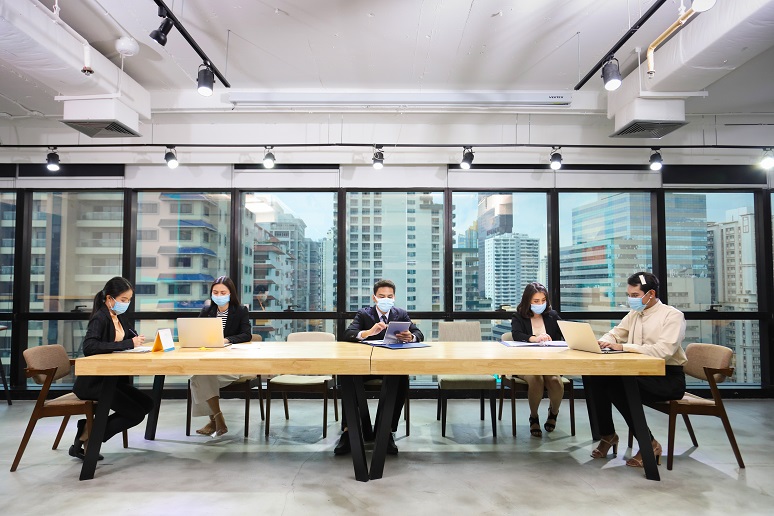Previously, many organizations struggled to create a well-designed and standardized audio/visual (A/V) experience that met the diverse needs of users in various sizes of conference rooms. Then, COVID-19 produced a new dynamic and an explosion in the use of conferencing tools.
Our company is no exception, and in January of this year, we started a redesign and standardization of our office conference rooms–approximately 25 spaces in six different locations. What began as an internal project to update and remodel has morphed into overhauling our approach to design future conference rooms based on our pandemic experience.
Initial Approach
At the end of 2019, we saw the need to tailor all of our conference room spaces with consistent A/V, network, and web conferencing equipment that was highly utilized and simple to operate. Conference rooms in our organization were a hodgepodge of different technologies, including interfaces from permanently hardwired minicomputers running Skype and Teams to higher-end cloud-based Tandberg/Cisco solutions. These systems also had varying degrees of A/V quality. We were looking to set a standard for all new conference rooms and update all existing ones to this new standard. We had some concerns about the real-time usage of the technology that would result from these new spaces, so there was a plan in place to launch a couple of rooms and monitor it via the AV control system.
Internal Talent
Our core business is technology design, so we wanted to highlight and promote this knowledge in our conference rooms. We had the in-house expertise for this project because our A/V, unified communications (UC), and network technology design team were recently bolstered by acquisitions of three technology design firms in the past two years. As we started this design process, COVID hit, and our attention and energies shifted towards staying profitable while maintaining and supporting our entire remote staff. In the last two months, we have been able to revisit this design issue.
Design for Ease-of-Use
To our understanding, utilization of any technology system is directly proportional to the user’s comfort in configuring and operating that system. That includes launching a simple web-based conference on a laptop to configuring and running a complicated multi-zone, divisible training center. Our coworkers and many professional friends got forced into setting up home offices and hosting multiple web conference meetings every week via Skype, Teams, Webex, Zoom, etc. With this newfound learning experience, the comfort level of conducting these web sessions has increased in our organization and for our clients. We must modify our future design approach to include this apparent technology paradigm shift and the design of any conferencing and presentation systems.
Design In-Motion
The approach to renovating and updating these conference rooms has also led to a review of A/V and web conferencing systems. With our business experiencing growth with all 500+ employees working remotely, leadership is making tough decisions now concerning lease renewal for large open space offices and continuation of staff working remotely. We realize from recent events that conference room design, in general, will substantially change. Our future office spaces, like that of our clients’ may look very different. Some initial brainstorming ideas mirror the recommendations we are now making for many clients and enterprises could benefit from the following:
- Provide web conferencing capabilities for every meeting space
- Replace wide open spaces (previously housing desks) with several mobile four-person tables that can be grouped to make larger collaborative tables. Doing this will accommodate sessions from two to 24 people.
- Incorporate rolling 5-foot high dividers to visually and acoustically separate these office groups.
- Incorporate Mobile Web Conference Cart with large LCD Monitor and integrated sound-bar/webcam/and tethered microphone table array that can be used by these groups for web conferences.
- Increase the quantity of enclosed small and medium huddle spaces to be used during web conferences. For smaller rooms, you could utilize kits (described below). For larger rooms, these can be outfitted with permeant systems or you can use the mobile carts described above.
- Provide employees with kits that include minimum 1080P/30fps webcams and USB microphones to conduct higher quality web conferencing with their laptops from anywhere we have found that our laptop webcams and microphones to be adequate for an interoffice conference, aren’t adequate for web conferences with clients.
- Minimize common surfaces touched - Several A/V Control system manufacturers such as Crestron and AMX have recently begun touting “touchless” control capabilities. This feature (which has been an available add-in for several years) allows control of a conference room system via your devices and not from communal button or touch panels.
Conference room designs must adapt to the current needs and leverage the new technologies that improve the user experience.
J.R. Simmons, Principal Consultant for COMgroup, a division of Ross & Baruzzini, contributed to this article.
"SCTC Perspective" is written by members of the Society of Communications Technology Consultants, an international organization of independent information and communications technology professionals serving clients in all business sectors and government worldwide.
Knowing the challenges many enterprises are facing during COVID-19, the SCTC is offering to qualified members of the Enterprise Connect user community a limited, pro bono consulting engagement, approximately 2-4 hours, including a small discovery, analysis, and a deliverable. This engagement will be strictly voluntary, with no requirement for the user/client to continue beyond this initial engagement. For more information or to apply, please visit us here.











